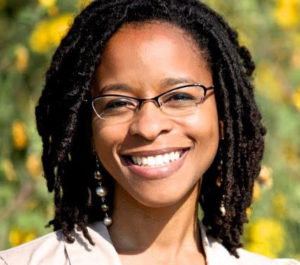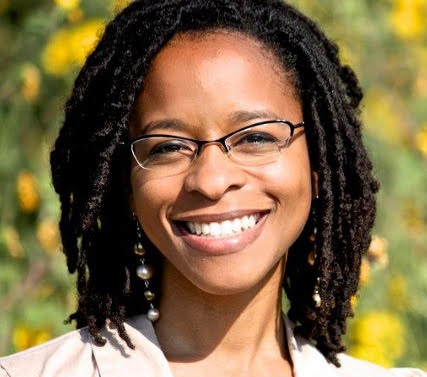By Korah Wiley
 Korah Wiley is a learning sciences researcher at Digital Promise with over ten years of classroom teaching experience. Her prior work as a STEM researcher instilled a passion for making the STEM fields more accessible to students and educators.
Korah Wiley is a learning sciences researcher at Digital Promise with over ten years of classroom teaching experience. Her prior work as a STEM researcher instilled a passion for making the STEM fields more accessible to students and educators.
As a student, I loved all the animal-related topics—topics about plants…not so much. When I became a biology teacher and got to the section on plant biology and photosynthesis in the curriculum I was using, I knew that I, like my students, would need to “hit the books”. However, I quickly found myself deep in the world wide web of teaching and learning resources available online, because I knew that reading a textbook was only going to take my understanding so far. To really understand the material deeply enough to teach it, I needed a multimedia resource. I searched high and low and finally found an animation of the process at a level of detail that would give me the confidence that I understood the process well enough to answer my students questions and support them in their learning process.
The learning process that I sought to engage my students in wasn’t the standard, memorize this information and take a test in a couple of weeks. Rather, it was the kind of learning called for by the Next Generation Science Standards (NGSS)—the three-dimensional integration type. At that time, the North Carolina School of Science and Mathematics was one of the lead state partner organizations for the development, adoption, and implementation of the NGSS. In preparation for the 2010-2011 school year, the science department dean shared the draft NGSS documents and essentially said, “This is the future of science learning and we will help lead the way.” So, as a department, we revised our current curriculum and instruction to align with the call of the NGSS to engage students in the practices of science and engineering with the goal of developing an integrated understanding of disciplinary core ideas and crosscutting concepts.
Finding this photosynthesis animation was great, because 1.) it helped me to understand photosynthesis better and 2.) I could use it to engage my students in the science practice of using a model to understand natural phenomena, particularly ones that are invisible to the naked eye. My students and I went on a journey inspired by the NGSS to learn more than just the what and why of photosynthesis, we were also learning the how. Learning how photosynthesis took place led us to an even more interesting question, what if? What if human cells could harness light and make energy? (It’s actually not as far-fetched as it sounds; Goodman & Bercovich, 2008.)
The question of “what if” led me down new paths when I joined a team to develop a middle school, STEM enrichment program for minoritized and first-generation, college-bound students, called Labs for Learning. What if we developed the program curriculum to engage the participants, rising 7th graders, in a rigorous learning experience, similar to the curriculum we developed to align with the NGSS? Would it be too much for students who were barely in middle school and in woefully under-resourced middle schools at that? Encouraged by the learning experiences we were supporting for our high school students, we took a chance!
I was responsible for teaching biology topics to the 7th graders, which, to my chagrin, included even more about plants! I relied on what I knew worked, the photosynthesis animation that was so helpful for me and my high school students. The animation, for all its awesomeness, was just out of reach for the middle school students, who were really intimidated by the names of the molecules and complexes. Wanting to figure out a way to still use the animation, (knowing that it could help them develop a deeper understanding of key concepts like energy and matter transformation), I told them to just focus on the process and ignore the names. (I figured if they understood the process then they could learn the names later.) This scaffolding ultimately led to physical reenactments of the process, where we turned the abbreviations of the molecule and complex names into initials of the characters. We all had a fantastic time, they all learned the process, and many were inspired to learn the full names of their characters. (It was so exciting to watch!)
These experiences stuck with me when I was deciding on my dissertation focus. In particular, there were three things that followed me into graduate school:
- the limited number of resources available to support secondary students in understanding the mechanism of biological phenomena,
- the deep capacity of middle school students for mechanistic reasoning, and
- the power of a well-designed animation to support robust learning for me and my students.
To help with these problems, I decided to create a photosynthesis animation that focused on the mechanism of photosynthesis such that middle school students (and their teachers) could develop the type of scientific and integrated understanding called for by the NGSS.
After making the animation, I embedded it into an online photosynthesis unit in the Web-based Inquiry Science Environment (WISE) to evaluate whether and to what extent it supported students to meet the NGSS performance expectation for photosynthesis (MS-LS1-6). I found that, similar to my Labs for Learning experience, middle school students are capable of understanding far more complex ideas than we give them credit for (publication under review). Even with as little starting knowledge as knowing the inputs and outputs of photosynthesis, namely that carbon dioxide and water go into the plant and sugar (glucose) and oxygen come out, they were able to learn the biochemical mechanism of the process. While the assessment boundary for the photosynthesis performance expectation states that assessment for the standard does not include the biochemical mechanism of photosynthesis, my findings along with those of numerous other studies say that the middle school students can handle it and can benefit from it in their future STEM learning (Ryoo & Linn, 2012; Russ et al., 2008; Krist et al., 2018). The framework documents for the NGSS, too, recognize the need for understanding mechanisms when developing and constructing scientific explanations (National Research Council, 2012). Answering the call of the NGSS and other ambitious science reform efforts to support students in developing integrated and multi-dimensional science knowledge requires an exploration of mechanisms.
Admittedly, deep exploration into unfamiliar topics is scary, especially as a teacher who is expected to know the answers. But what better way can a teacher support students in the learning process than if they join the process themselves? As the world changes, and learners can look in many places for answers, what they need is not the answer, they need a model of how to learn in a world where information abounds. Such a model will position students to know more than just the answers. They will know how to discover, how to use the wealth of resources available to them to find out. That’s what we can model for our students by learning with them.
At the rate that new information is being generated there is no way any one person can know everything. I suggest, find resources that push you to your edge and invite your students to also explore the edge of their knowledge and ability. You might not know the biochemical mechanism of photosynthesis, for example, but that’s okay, you can learn with them. Find a resource that helps you and scaffold it to help them. Doing so will model for your students how to move from not knowing to knowing a little more, and a little more.
When you do this, you can also help them understand why it matters, and more importantly, why it matters to you. Share with them what’s interesting about the topic to you. Invite them to explore their ideas and share their experience to find out why it matters to them. Position them as pioneers in a space that could make that knowledge worth knowing for someone else. Invite them into the world of imagination and what if; prompting them with, this is the current state but what could be?
These are just some of the learning adventures that you can take with your students. The NGSS is an invitation to deeper more meaningful discovery and learning, for the students as well as the teachers. Your students need a brave guide into the world of the unknown. If you can find resources that allow you to share that space with them, they will appreciate your guidance and example of how to learn throughout their life.
Now that I’ve done this work, I understand how exploring the mechanisms of different phenomena creates rich and transformative learning experiences for ourselves and our students. With the world moving and changing as fast as it is, we need to support students in learning as much as they can, which oftentimes is more than we think!
Acknowledgments. I need to note that the animation discussed here was created in collaboration with a multistakeholder design team, that included disciplinary experts, learning scientists, software developers, teachers and students. My dissertation work was funded by the National Science Foundation (DRL: 1418423; 1813713).
References:
Krist, C., Schwarz, C. V., & Reiser, B. J. (2018). Identifying essential epistemic heuristics for guiding mechanistic reasoning in science learning. Journal of the Learning Sciences, 28(2),
160–205. doi: 10.1080/10508406.2018.1510404
National Research Council. (2012). A Framework for K-12 Science Education: Practices, Crosscutting Concepts, and Core Ideas. Washington, D.C.: National Academies Press. doi: 10.17226/13165
Russ, R. S., Scherr, R. E., Hammer, D., & Mikeska, J. (2008). Recognizing mechanistic reasoning in student scientific inquiry: A framework for discourse analysis developed from philosophy of science. Science Education, 92(3), 499–525. doi: 10.1002/sce.20264
Ryoo, K., & Linn, M. C. (2012). Can dynamic visualizations improve middle school students’ understanding of energy in photosynthesis? Journal of Research in Science Teaching, 49(2), 218–243. doi: 10.1002/tea.21003
Educator CIRCLS posts are licensed under a Creative Commons Attribution 4.0 International License. If you use content from this site, please cite the post and consider adding: “Used under a Creative Commons Attribution 4.0 International License (http://creativecommons.org/licenses/by/4.0/).”
Suggested citation format: [Authors] ([Year]). [Title]. Educator CIRCLS Blog. Retrieved from [URL]

